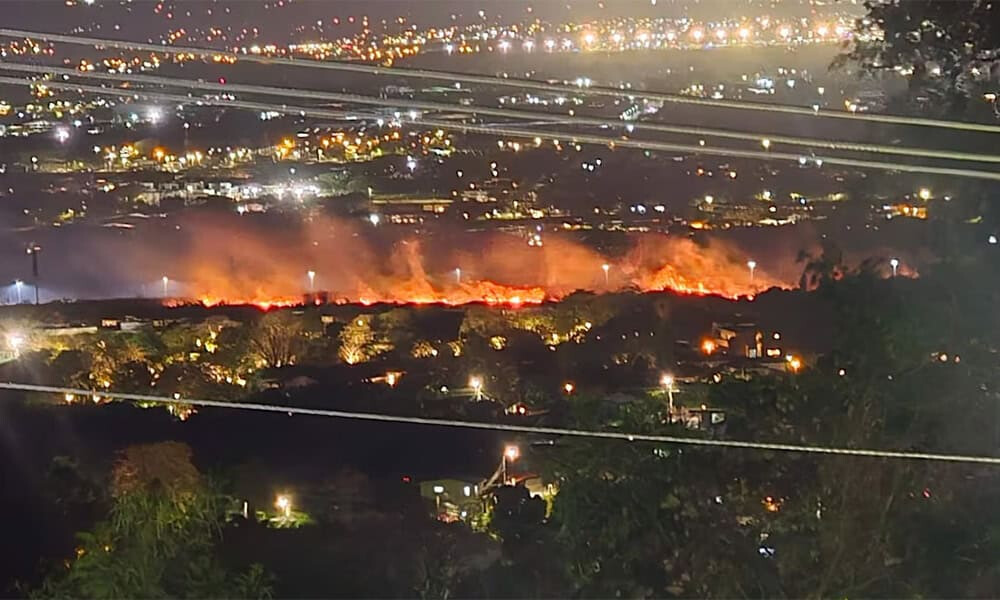
Pozos de Santa Ana, Costa Rica – A fire that swept through a section of Lorne Ross Park in Pozos de Santa Ana on Wednesday night has not only prompted an investigation into its cause but has also intensified a heated political debate surrounding the future of the protected area. The blaze, which consumed approximately five hectares of pastureland within the 52-hectare park bordering Route 27 to Caldera, has become the latest flashpoint in a contentious dispute over conservation versus development.
The National System of Conservation Areas (SINAC) confirmed the fire erupted around 7:00 p.m., quickly becoming visible to commuters along the busy highway. The Costa Rican Fire Department responded swiftly, deploying seven units to combat the flames. Fire Chief Héctor Chaves reported that the fire’s spread was contained by 9:30 p.m., with firefighters working well past midnight to extinguish lingering embers in the affected area.
According to firefighter Maynard Zumbado, the challenging terrain, coupled with strong winds, complicated firefighting efforts. Thick smoke billowed across Route 27, causing temporary traffic disruptions and underscoring the potential dangers of such incidents near major roadways. The Ministry of Environment and Energy (MINAE), through SINAC’s Fire Management Department, played a crucial supporting role, prioritizing the protection of historically significant structures within the park, including a traditional farmhouse (casona) and a sugar mill (trapiche), as well as nearby residences. Fortunately, no infrastructure was damaged.
A team from the Central Conservation Area’s (ACC-SINAC) Fire Management Program conducted a thorough site inspection on Thursday morning. “Our initial assessment indicates that only pastureland was affected by the fire. No forest or infrastructure suffered any damage,” stated ACC-SINAC Director Meryll Arias. She further emphasized the effectiveness of preventative measures, noting that “firebreak lines established by our team and volunteers from the ASVO (likely a local environmental association) on March 4th, as part of our routine dry-season preparedness, were instrumental in protecting the historic buildings.”
While the immediate damage appears limited, the incident has triggered a formal investigation. The Judicial Investigation Agency (OIJ) has requested the Fire Department’s Engineering team to determine the fire’s origin. SINAC officials suspect the blaze may have been intentionally started through vandalism at the roadside, raising concerns about public safety and the vulnerability of the park.
MINAE-SINAC has issued a public appeal for vigilance in preventing forest fires, highlighting the detrimental environmental consequences, including the loss of vital carbon reserves, the exacerbation of climate change, threats to Costa Rica’s rich biodiversity, and the potential hazards for road users. Alarmingly, this fire marks at least the 32nd such incident in the vicinity since 2020, as reported by Diario Extra, painting a picture of a region particularly susceptible to wildfires.
The incident has swiftly escalated into a political showdown. Former President Laura Chinchilla voiced her strong condemnation on social media, directly accusing MINAE of negligence in its duties. She also targeted Congresswoman Pilar Cisneros, alleging a disregard for Costa Rica’s natural heritage in favor of a plan to repurpose the park for personal gain. This accusation stems from Cisneros’ recent proposal to transform Lorne Ross Park into a “Water Park.”
Adding to the political fallout, Deputy Kattia Cambronero reported live updates from the scene on X (formerly Twitter) on Wednesday evening. Her posts highlighted the fire’s intensity and raised concerns about the availability of resources, stating that firefighters had deployed four units but required a water tanker due to a lack of water in the area. She later described MINAE’s oversight as “indignante,” further fueling the criticism against the environmental agency.
Lorne Ross Park has become a significant point of contention in recent months due to Congresswoman Cisneros’ push for its redevelopment into a “Water Park.” This proposal has been met with staunch opposition from the Lorne Ross Pro-Natural Park Movement and numerous local residents. These groups argue vehemently that such a transformation would fundamentally undermine the park’s original ecological purpose as a vital green space and a sanctuary for local flora and fauna. They have actively campaigned against the proposed “Water Park,” urging the public and authorities to prioritize conservation efforts.
As the investigation into the cause of the fire unfolds, the incident has undoubtedly added another layer of complexity to the ongoing debate surrounding the future of Lorne Ross Park. The blaze serves as a stark reminder of the potential risks to natural areas and has amplified the fundamental question of who will ultimately decide the fate of this valuable piece of Costa Rican land. The clash between conservation advocates and those seeking development highlights a broader tension within Costa Rica as it navigates the balance between economic progress and the preservation of its renowned natural heritage.
[Copyright (c) Global Economic Times. All Rights Reserved.]






























